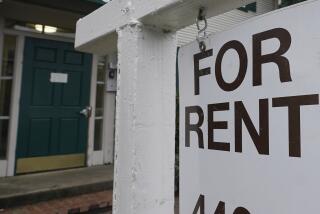Personal Perspective : Quake Aid That’s Keeping the Poor Out in the Cold
- Share via
How does the government spell earthquake relief if you are poor and non-English speaking?
G-O-O-D L-U-C-K.
Even before the Northridge earthquake, the availability of low- income housing in the San Fernando Valley was woefully short of the need. The “doubling-up” of families in single-family apartments was common. Worse, families constituted an ever-increasing share of the homeless population in the Valley. Regrettably, quake-relief efforts have served to underline just how intractable this housing shortage is--and why the government’s programs may be doomed to failure.
The Department of Housing and Urban Development administrators of the Section 8 housing-voucher program were probably oblivious to the lack of low-income housing in the Valley. They may have not known that the Civil Rights Division of the Department of Justice recently filed a housing-discrimination suit against more than 3,000 landlords in the San Fernando Valley, mostly on the west side.
But the result is clear and cruel. Quake-displaced poor families of color, with incomes of less than $20,000, have been given a piece of paper that offers them new shelter in a region where there are few available housing units and where they are unwanted. Which may explain why, as of last week, less than 5% of the nearly 10,000 rent-subsidy certificates distributed by the Federal Emergency Management Agency had been cashed in.
Moreover, according to some of my neighbors who have received the low-income certificates, failure to find a landlord willing to accept the Section 8 voucher within 60 days--the program is voluntary--will result in removal from the program. Unfortunately, as one displaced resident told me, most landlords “don’t want those folks on welfare.” Even the worst quake in modern L.A. history can’t knock down the San Fernando Valley’s “color barriers” and income prejudice.
Authorities have belatedly begun to recognize the problem of finding Section 8 housing in the Valley--fewer than 500 units, according to a list supplied by the Rent Stabilization Division of the city Housing Department.
FEMA is also gradually discovering that what housing is available tends to be clustered in the Valley’s poorer neighborhoods, reflecting the area’s longtime housing discrimination. Channeling quake victims to these communities would be tantamount to reinforcing racially segregation patterns, a clear violation of any HUD mandate.
HUD would face the same dilemma if it decided to move the quake-displaced to available low-income housing in other parts of the city, such as in South-Central. Furthermore, even if it could, the agency would be relieving some of the pressure on the Valley landlords who have been charged with discrimination. The quake has thus exposed a problem the city can no longer avoid: the clustering of Section 8 housing.
There are two short-term solutions. Housing placement assistance must be provided by those who are issuing the vouchers. If anything, at least FEMA should document the persistence of discriminatory housing practices alleged by the Justice Department.
Second, if the use of Section 8 vouchers proves to be an unmovable barrier to finding housing in the Valley, the architects of the quake-relief program ought to consider distributing housing grants, good for 18 months, to the displaced. This would overcome the stigma attached to the Section 8 certificates.
Short of this, Los Angeles’ quake-displaced poor may be indefinitely exiled to “temporary shelters” and “tent cities.”*
More to Read
Sign up for Essential California
The most important California stories and recommendations in your inbox every morning.
You may occasionally receive promotional content from the Los Angeles Times.










